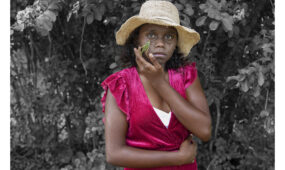'Arm's length' funding crucial for arts body
InReview

The Australia Council is more than a government piggy-bank, writes Flinders University professor Julian Meyrick in a Conversation article provoked by the battle over sponsorship of the 2014 Sydney Biennale of Sydney.
Things to remember if you are a federal minister for the arts:
1. In arts policy, as in the arts, how you do things matters as much as what you do. Good ideas become bad ideas if your tone is wrong or you aim at the wrong audience.
2. Breaking news: artists are difficult to deal with. There’s no money in art, so people stick to their principles like flies to a jam tart. Trying to change those principles by threatening their funding only makes things worse.
3. Whatever happens in politics ends up in the arts. That’s because it’s artists’ job to be socially responsive. So no Fake Shock when art ends up a battleground for the issues of the day.
4. The arts and arts policy are not in stable orbit. They don’t revolve in a genteel way, but zoom about, like Sandra Bullock and George Clooney in Gravity, trying not to kick each other’s teeth in.
There’s more, but these are the most pertinent as Senator George Brandis, the current federal arts minister, continues to respond to the ongoing furore surrounding the 2014 Biennale of Sydney, which begins today.
Brandis reportedly directed the Australia Council to revise its sponsorship guidelines in the wake of the Biennale boycott and has since reiterated his view that it is unreasonable for arts companies to refuse sponsorship on political grounds.
Last Thursday on The Conversation, Peter Tregear brought some much-needed perspective to this fractious dispute. He called the relationship between the arts and politics “awkward”, and pointed out the contradictions in Brandis’ seeming determination to force arts organisations to accept sponsorship from any “commercially sound” business.
The dispute involves hard issues – “hard” as in “real” and “difficult to solve”. But it also reflects trends in the provision of arts subsidy. Considerable fur has flown concerning the right of artists to protest the involvement of Transfield Services in the Biennale.
What has caused less comment is the constant muddling of “public assistance” with “government funding” – and the related suggestion that if artists really want to object to the federal policy of mandatory detention, they should refuse Australia Council support on the basis that it, too, is tainted money.
This is a ludicrous proposition with no basis in logic or reality. Why not refuse Medicare or educational services or military protection since the government provides those also? Except it doesn’t. They are provided by taxpayers, and the government of the day has a leading, but not a dictatorial, say on the purpose and extent of such expenditure.
The arm’s length principle
Brandis’ comments about Australia Council funding indicate a fresh erosion of the “arm’s length” relationship between the agency and the government that was a principle of its foundation in 1973.
Since then, ministers of all political hues have often pursued policy objectives without due regard for the agency’s statutory independence. The most notorious occasion was what Justin McDonnell, in his book Arts, Minister? (1992), calls the “Great Redistribution Debate” of 1983-4. Back then, the Australia Council imposed a $A300,000 grant limit on all arts organisations. Going behind its back, Prime Minister Bob Hawke provided Cabinet-level funding for select companies that left the agency’s strategic plan in tatters.
Over time arts ministers’ arms have got shorter and shorter.
They have front-loaded equity and access (Barry Cohen, Hawke’s arts minister), excellence and quality (Paul Keating), cost-effectiveness and financial stability (Richard Alston, under Howard), and innovation and technology (Simon Crean, under Gillard).
In the 1990s, the Council was reorganised to make its art form boards more responsive to direction from above, while the federal Office for the Arts effectively became a rival grant body.
In 2012, a review of the operation of the Australia Council prescribed “a more formalised requirement for communication and planning with the Australian Government”. The review was the basis of a new Australia Council Act, passed into law last year by the Gillard government.
Former arts minister Tony Burke is right to warn of Senator Brandis’ interventionism in the arts – but it was his government that put in place the legislation to facilitate it.
It’s as if successive governments, having granted the Australia Council independence, then regretted it. Yet they have never had the courage to replace it with a ministry and take responsibility for their own actions. Or perhaps it’s convenient to have the agency do the government’s dirty work for it. Ministers can claim they aren’t interfering in the arts directly – while leaning on the Council to “tighten guidelines”.
At first blush, the Council’s loss of independence would be no disaster. Why shouldn’t governments determine cultural expenditure? Better than having the agency a captive of its clients.
Before the Australia Council
But look further back, to the Council’s predecessor, the Australian Elizabethan Theatre Trust (AETT), and you’ll see that what Brandis takes as an unambiguously good thing – corporate involvement in the arts – was partly what persuaded people an independent arts agency was needed in the first place.
The AETT, established in 1954, was a silvertail affair, narrow and inept in equal measure, controlled by Australia’s business and social elite. It gave out tax credits and guarantees against loss that proved unaccountable, inequitable and difficult to quantify on a Treasury ledger.
The AETT was a body that had almost no artists on it. Its decisions about which projects to support became increasingly erratic. Artists’ representation at board level was a hot topic when the AETT was replaced in 1968 by the Australian Council for the Arts, and again in 1975 when the Australia Council achieved statutory independence.
It is one thing to say that corporate sponsorship – which is different from corporate philanthropy (another confusion in the current debate) – is an important part of the funding mix.
It is another to assert it is “the heart and soul of good funding policy”. Corporate involvement in the arts brings with it problems as well as benefits, and needs as much judicious handling as direct public assistance.
How will the Australia Council react?
The Council’s reaction will be a crucial test of how much backbone it has left after years of political traducing. It was set up as an advocacy body for the arts to the government. More often it has been the government’s representative in the field, or got caught in the middle, talking to two sides who won’t talk to each other.
You only have to read Justin McDonnell’s much-underrated book on Australian arts funding over the decades to see how similar the Biennale dispute is to blow-ups in the past.
But the minister and artists must also now act with some care. It is a small step from insisting arts organisations accept corporate sponsorship when offered, to insisting they meet sponsorship targets. This would affect the 28 major performing arts companies particularly – and Senator Brandis could unwittingly be paving the way for the elimination of direct subsidy to these bodies.
That would make them entirely non-responsive to the government’s agenda and even more socially exclusive than they currently are.
For artists, faced with the issue of how far to extend their protest, there is a need to ensure that, in pursuing activist goals, the agency isn’t further eviscerated.

Get InReview in your inbox – free each Saturday. Local arts and culture – covered.
Thanks for signing up to the InReview newsletter.
The Council is more than a government piggy-bank. It is a living symbol of the accord between the Australian people and Australian artists, a guarantee of free speech in the cultural arena. From a policy point of view, this freedom is neither a right nor a privilege, but an accomplishment.
It relies on all parties respecting the institutional parameters in which it is enacted.
Like a spreading stain, the government’s policy of mandatory detention has caught the Biennale and downed its well-intentioned patron, Luca Belgiorno-Nettis. I doubt it has finished spreading yet.
Julian Meyrick is Professor of Strategic Arts at Flinders University. This article was first published on The Conversation.
Support local arts journalism
Your support will help us continue the important work of InReview in publishing free professional journalism that celebrates, interrogates and amplifies arts and culture in South Australia.
Donate Here





Comments
Show comments Hide comments